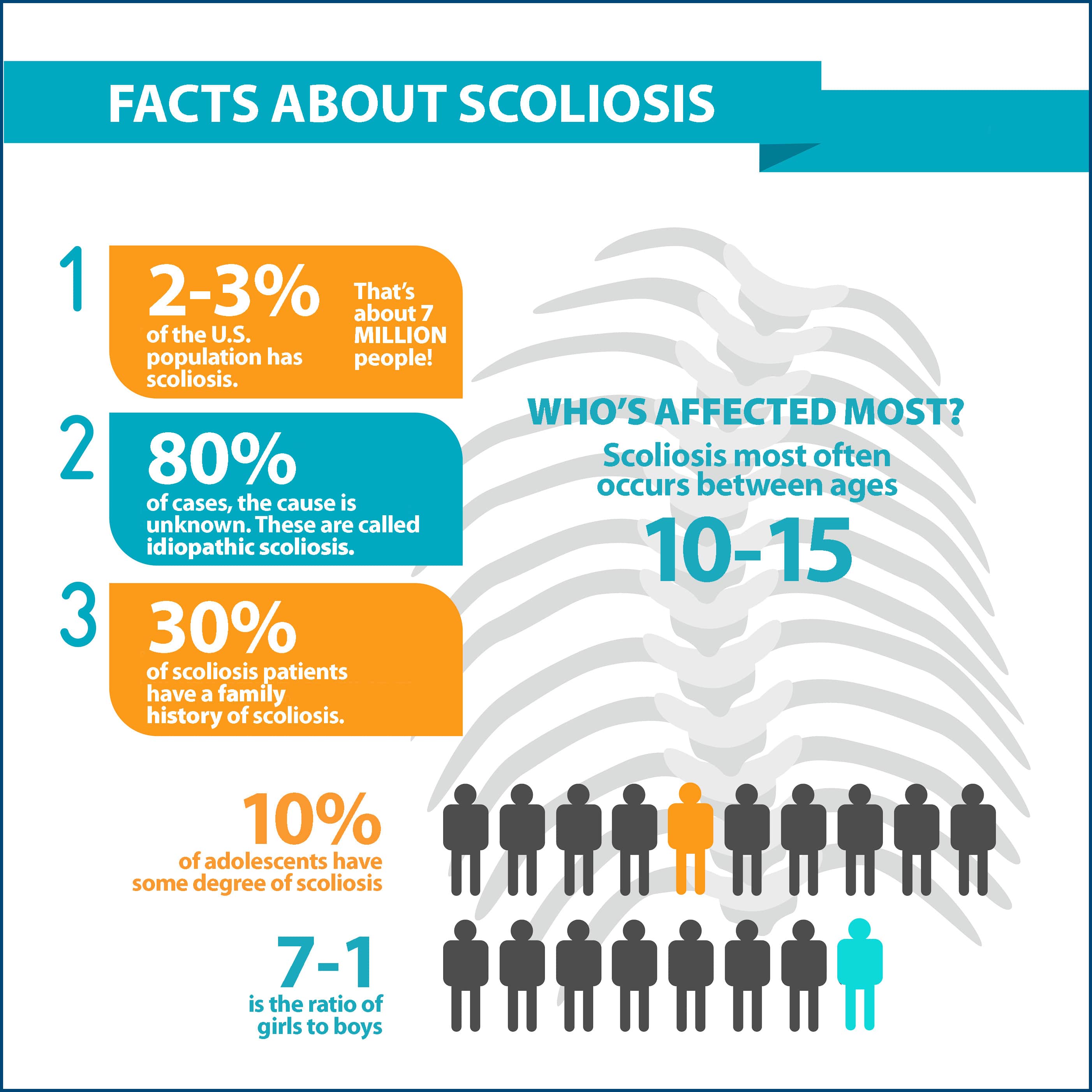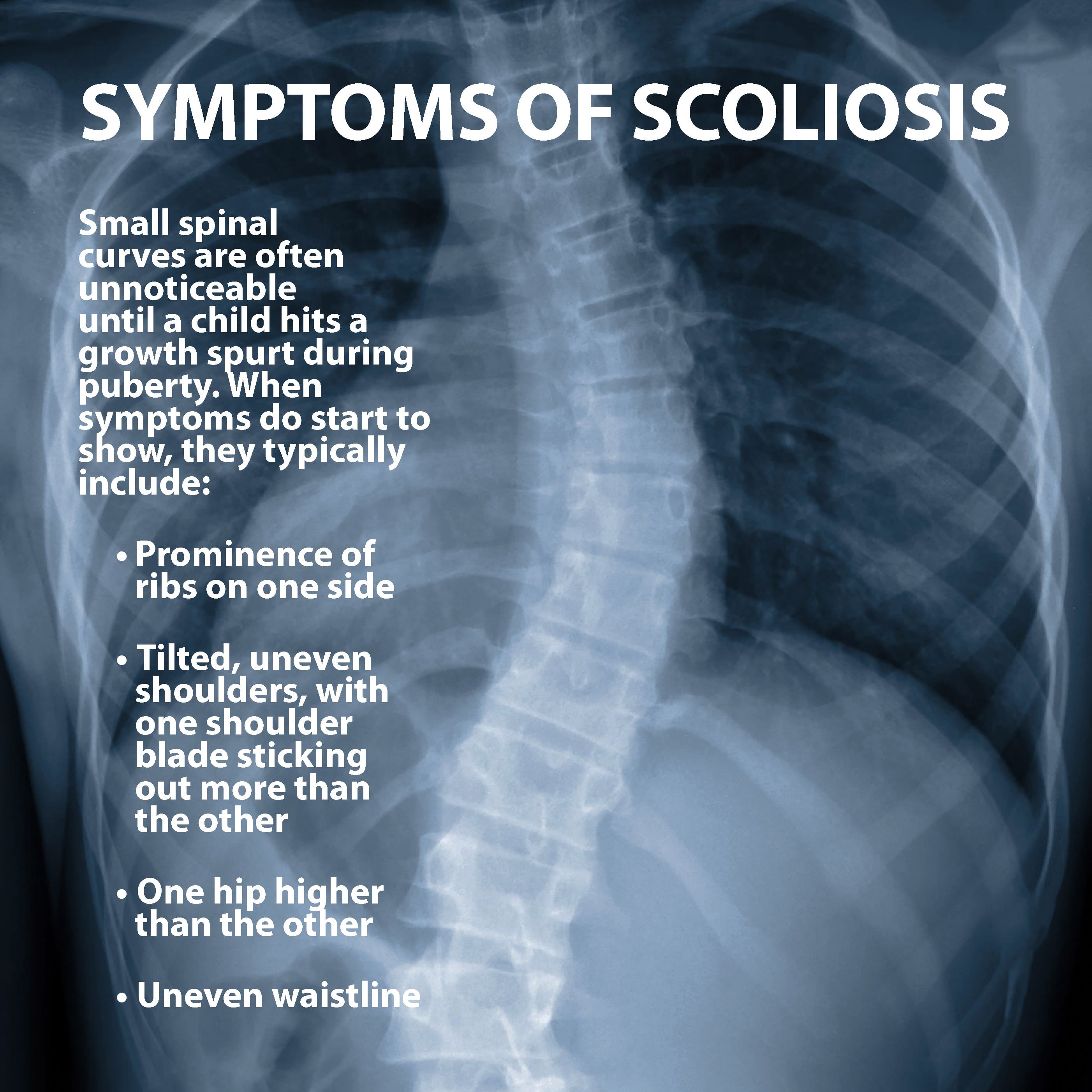SCOLIOSIS
OVERVIEW
Scoliosis is a condition found in children that causes the spine to curve in a “C” or “S” shape. When a child is young, before they hit puberty, the scoliosis is often unnoticeable. But as they grow and go through puberty, the spinal deformities become visible and get worse. There are both surgical and nonsurgical treatments available to help either prevent the spine deformity from getting worse and to completely realign the spine.
ANATOMY
The spine consists of 33 individual bones known as vertebrae that interlock. The vertebrae are categorized into five regions:
- Cervical
- Thoracic
- Lumbar
- Sacrum
- Coccyx
DESCRIPTION
Scoliosis is a condition that causes the bones of the spine to twist or rotate resulting in a deformed spine, shaped more like the letter “C” or “S” rather than a straight line. This deformity most commonly occurs in the upper and middle back (thoracic spine), but it can also affect the lower part of the back.
Scoliosis develops in toddlers and young children but symptoms usually do not start appearing until puberty, when the child starts to grow. Both girls and boys and develop scoliosis, but girls are more likely to develop larger curves than boys and are more likely to get the condition.

The curves themselves vary in size. Mild curves are more common than larger ones. If a child is still growing, a scoliosis curve can worsen quickly during a growth spurt if not treated.
SYMPTOMS
Small spinal curves are often unnoticeable until a child hits a growth spurt during puberty. When symptoms do start to show, they include:
- Prominence of ribs on one side.
- Tilted, uneven shoulders, with one shoulder blade sticking out more than the other.
- One hip higher than the other.
- Uneven waistline.

DIAGNOSIS
Your Florida Orthopaedic Institute physician will first test for scoliosis by performing the Adam’s forward bend test. During this test, your child will bend forward with their feet together and knees straight. Your physician will observe your child’s back, looking for a difference in the shape of the ribs on each side. This position makes spinal deformities more noticeable and easier to detect.
Additionally, your physician will look at your child standing upright and check if the hips and shoulders are level and if the position of the head is centered over the hips. To rule out other causes of spinal deformity, your physician may also check for abnormal neurological findings, limb-length differences, and other physical issues.
X-rays may also be taken to provide a clear image of your child’s spine. Generally, curves greater than 25° are considered severe enough to need treatment.

TREATMENT OVERVIEW
Your Florida Orthopaedic Institute physician will consider several things when determining the best treatment plan for your child. These things include:
- The severity of the curve.
- The location of the curve.
- Your child’s age.
- The number of remaining growing years.
There are both non-surgical and surgical treatment options available for scoliosis. Surgical treatments are only recommended if the spinal curve is greater than 45° to 50° or if non-surgical treatments are unsuccessful.
NON-SURGICAL TREATMENTS
There are several non-surgical treatment options available, including:
- Observation. If your child’s spinal curve is less than 25°, or if he or she is almost full-grown, your physician may recommend simply monitoring the curve to make sure it does not get worse. Your physician will recheck your child ever 6 to 12 months and schedule x-rays regularly until your child is fully grown.
- Bracing. If the spinal curve is between 25° and 45° and your child is still growing, your physician may recommend bracing. Although bracing will not straighten an existing curve, it often prevents it from getting worse to the point of requiring surgery. There are several different types of braces for scoliosis and are recommended depending on the severity and location of the curve. Most of these braces are underarm braces that are custom made to fit your child comfortable. Braces can be hidden under clothing and can be taken off for sports activities.
SURGICAL TREATMENTS
Surgery may be recommended if bracing did not work or if your child’s spinal curve is greater than 45°-50°. Spinal fusion is the primary surgical procedure used to straighten the spine. During this procedure, the spinal bones that make up the spinal curve deformity are realigned. Small pieces of bone (bone graft) are placed into the spaces between the vertebrae and fused together with the realigned section of the spine. Metal rods are usually used to hold the bones in place until the fusion happens, attached to the bone using hooks, screws, and wires. Only the deformed section of the spine is fused together, everything else is left alone.
This procedure will stop growth in the part of your child’s spine that is affected by scoliosis.
NEXT STEPS
By the second day after surgery, most patients are able to walk without a brace and are usually discharged from the hospital less than a week following surgery. Most children can return to school and resume daily activities within a month. Sports activities can be resumed 6 to 9 months.
If you are concerned that your child has an abnormal curvature of the spine, schedule a consultation today with one of the fellowship trained spine physicians at Florida Orthopaedic Institute.
Areas of Focus
- Spine
- Anterior Cervical Corpectomy & Discectomy
- Artificial Disk Replacement (ADR)
- Bone Cement Injection
- Degenerative Disk Disease
- Diffuse Idiopathic Skeletal Hyperostosis (DISH)
- Discectomy
- Discitis Treatment & Information
- Epidural Injections for Spinal Pain
- Foraminotomy
- Interlaminar Implants
- Interlaminar Lumbar Instrumental Fusion: ILIF
- Kyphoplasty (Balloon Vertebroplasty)
- Kyphosis
- Laminectomy: Decompression Surgery
- Lumbar Epidural Steroid Injection
- Lumbar Interbody Fusion (IBF)
- Minimally Invasive Spine Surgery
- Outpatient Spine Surgery
- Pinched Nerve
- Piriformis Syndrome
- Sacroiliac Joint Pain
- Sciatica
- Scoliosis
- Spinal Fusion
- Spondylolisthesis and Spondylolysis
- Vertebroplasty
- Whiplash and Whiplash Associated Disorder (WAD)
The following Florida Orthopaedic Institute physicians specialize in Scoliosis:
Specialties
- AC Joint Injuries
- Achilles Tendinitis - Achilles Insertional Calcific Tendinopathy (ACIT)
- Achilles Tendon Rupture
- Achilles Tendonitis
- ACL Injuries
- Ankle Fracture Surgery
- Ankle Fractures (Broken Ankle)
- Ankle Fusion Surgery
- Anterior Cervical Corpectomy & Discectomy
- Arthroscopic Articular Cartilage Repair
- Arthroscopic Chondroplasty
- Arthroscopic Debridement of the Elbow
- Arthroscopy Of the Ankle
- Articular Cartilage Restoration
- Artificial Disk Replacement (ADR)
- Aspiration of the Olecranon Bursa - Fluid In Elbow
- Atraumatic Shoulder Instability
- Avascular Necrosis (Osteonecrosis)
- Bankart Repair
- Basal Joint Surgery
- Bicep Tendon Tear
- Bicep Tenodesis
- Bone Cement Injection
- Bone Growth Stimulation
- Bone Health Clinic
- Broken Collarbone
- Bunions
- Bursitis of the Shoulder (Subacromial Bursitis)
- Calcific Tendinitis of the Shoulder
- Carpal Tunnel Syndrome
- Charcot Joint
- Chiropractic
- Clavicle Fractures
- Colles’ Fractures (Broken Wrist)
- Common Foot Fractures in Athletes
- Community Outreach
- Cubital Tunnel Syndrome
- De Quervain's Tenosynovitis
- Deep Thigh Bruising
- Degenerative Disk Disease
- Diffuse Idiopathic Skeletal Hyperostosis (DISH)
- Discectomy
- Discitis Treatment & Information
- Dislocated Shoulder
- Dupuytren’s Disease
- Elbow
- Elbow Bursitis
- Elbow Injuries & Inner Elbow Pain in Throwing Athletes
- Epidural Injections for Spinal Pain
- Finger Dislocation
- Flexor Tendonitis
- Foot Stress Fractures
- Foot, Ankle & Lower Leg
- Foraminotomy
- Fractured Fingers
- Fractures Of The Shoulder Blade (Scapula)
- Fractures Of The Tibial Spine
- Functional Nerve Transfers of The Hand
- Ganglion Cysts
- General Orthopedics
- Glenoid Labrum Tear
- Golfer's Elbow
- Groin Strains and Pulls
- Growth Plate Injuries Of The Elbow
- Hallux Rigidus Surgery - Cheilectomy
- Hammer Toe
- Hamstring Injuries
- Hand & Finger Replantation
- Hand & Wrist
- Hand Nerve Decompression
- Hand Skin Grafts
- Hand, Wrist, Elbow & Shoulder
- Heat Injury/Heat Prostration
- High Ankle Sprain (Syndesmosis Ligament Injury)
- Hip & Thigh
- Hip Arthroscopy
- Hip Dislocation
- Hip Flexor Strains
- Hip Fractures
- Hip Hemiarthroplasty
- Hip Impingement Labral Tears
- Hip Muscle Strains
- Hip Pointers and Trochanteric Bursitis
- Hyperextension Injury of the Elbow
- Iliopsoas Tenotomy
- Iliotibial Band Syndrome
- Impingement Syndrome of the Shoulder
- Interlaminar Implants
- Interlaminar Lumbar Instrumental Fusion: ILIF
- Interventional Pain Management
- Interventional Spine
- Intraarticular Calcaneal Fracture
- Joint Replacement
- Knee & Leg
- Kyphoplasty (Balloon Vertebroplasty)
- Kyphosis
- Labral Tears Of The Hip (Acetabular Labrum Tears)
- Laminectomy: Decompression Surgery
- Lateral Collateral Ligament (LCL) Injuries
- Lisfranc Injuries
- Little League Shoulder
- LITTLE LEAGUER'S ELBOW (MEDIAL APOPHYSITIS)
- Lumbar Epidural Steroid Injection
- Lumbar Interbody Fusion (IBF)
- MACI
- Mallet, Hammer & Claw Toes
- Medial Collateral Ligament Injuries
- Meniscus Tears
- Metatarsalgia
- Minimally Invasive Spine Surgery
- Morton’s Neuroma
- Muscle Spasms
- Muscle Strains of The Calf
- Nerve Pain
- Neuromas (Foot)
- Neurosurgery
- Olecranon Stress Fractures
- Orthopaedic Total Wellness
- Orthopaedic Trauma
- Orthopedic Physician Or A Podiatrist? Definition of a Podiatrist
- Osteoarthritis of the Hip
- Osteoporosis
- Outpatient Spine Surgery
- Partial Knee Replacement
- Patellar Fracture
- Pelvic Ring Fractures
- Peripheral Nerve Surgery (Hand) Revision
- Pinched Nerve
- Piriformis Syndrome
- Piriformis Syndrome
- Plantar Fasciitis
- Plastic Surgery
- Podiatry
- Primary Care Sports Medicine
- Quadriceps Tendon Tear
- Radial Tunnel Syndrome (Entrapment of the Radial Nerve)
- Revascularization of the Hand
- Reverse Total Shoulder Replacement
- Rheumatoid Arthritis (RA) of the Shoulder
- Rheumatoid Arthritis Of The Hand
- Robotics
- Rotator Cuff Tears
- Runner's Knee
- Sacroiliac Joint Pain
- Sciatica
- Scoliosis
- Senior Strong
- Shin Splints
- Shoulder
- Shoulder Arthritis
- Shoulder Arthroscopy
- Shoulder Injury: Pain In The Overhead Athlete
- Shoulder Replacement
- Shoulder Separations
- Shoulder Socket Fracture (Glenoid Fracture)
- SLAP Tears & Repairs
- Spinal Fusion
- Spine
- Spondylolisthesis and Spondylolysis
- Sports Foot Injuries
- Sports Hernias (Athletic Pubalgia)
- Sports Medicine
- Sports Wrist and Hand Injuries
- Sprained Ankle
- Sprained Wrist Symptoms and Treatment
- Subacromial Decompression
- Sudden (Acute) Finger, Hand & Wrist Injuries
- Targeted Muscle Reinnervation (TMR)
- Tendon Transfers of The Hand
- Tennis Elbow Treatment
- Thigh Fractures
- Thigh Muscle Strains
- Thumb Ulnar Collateral Ligament Injuries
- Total Ankle Replacement
- Total Hip Arthroplasty
- Total Hip Replacement - Anterior Approach
- Total Knee Replacement Surgery
- Trapezius Strain (Muscle Strain of The Upper Back)
- Traumatic Shoulder Instability
- Tricep Pain & Tendonitis
- Trigger Finger
- Turf Toe
- UCL (Ulnar Collateral Ligament) Injuries
- Ulnar Neuritis
- Valgus Extension Overload
- Vertebroplasty
- WALANT (Wide Awake Local Anesthesia No Tourniquet)
- Whiplash and Whiplash Associated Disorder (WAD)
- Wound Care
- Wrist Arthroscopy
- Wrist Fractures
- Wrist Tendonitis
Services
- Physical Medicine & Rehabilitation
- Physical Therapy
- Primary Care Sports Medicine
- PROMs (Patient-Reported Outcome Measures)
- Same-Day Orthopaedic Appointments Now Available
- Sports Medicine
- Sports-Related Concussion Treatment
- Telehealth Page
- Telemedicine
- Workers' Compensation
- Workers' Compensation Dispensary
- X-Ray
